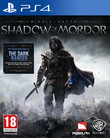With long hair, magic rings and creepy goblin blokes aplenty, Middle-Earth: Shadow of Mordor feels like the fantasy-themed lovechild of Assassin's Creed and Batman: Arkham City - and that's not a bad thing. Whether you're exploring, scouting and clambering up buildings with all the nimbleness of an assassin, or beating up orcs like you're wearing the famous cape and cowl of the Dark Knight himself, if you're a fan of either game, you'll quickly find yourself on familiar footing in your journey into Middle Earth. However, Shadow of Mordor is more than just a rehash. While it may borrow heavily from other games, it has plenty of new ideas of its own too, the most impressive of which is the Nemesis System - a living, breathing and squabbling hierarchy of orcs, which influences every aspect of the game.
Shadow of Mordor's Nemesis System will provide you with some of the most memorable, bitter and personal rivalries that you've ever experienced in a game. Although things can get a bit fuzzy, with some weird issues popping up as the game progresses, the Nemesis System still manages to feel like a wholly different and excitingly fresh take on how you engage with your enemies.
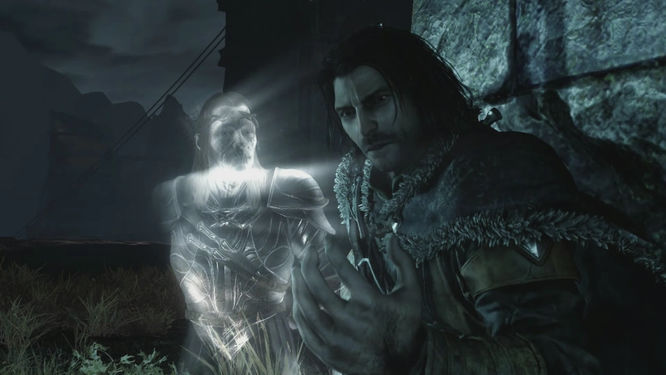
Shadow of Mordor is a hack 'n' slash 3rd person action-adventure/role playing game hybrid set in Tolkien's well-loved fantasy world. The story takes place between the events of The Hobbit and The Lord of The Rings, and sees you take on the role of Talion (voiced by the ever-omniscient Troy Baker), a Gondor Ranger who's returned from the dead, and is out to take his revenge on the Black Hand of Sauron and the Black Captains - the group responsible for killing his family and... well, him (don't worry about spoilers, it happens right at the start of the game). Technically not dead, but actually cursed instead, at your moment of "death", by way of a handy coincidence, you end up being inhabited by and bonded with the mysterious spirit of a dead elf Lord, Celebrimbor, who shares your physical body and comes complete with his own wraith powers (not to mention a tasty longbow). Together, your goal is to break the curse and get your revenge for your family's slaughter, whilst simultaneously recovering the memories of your newfound ghostly elf acquaintance along the way.
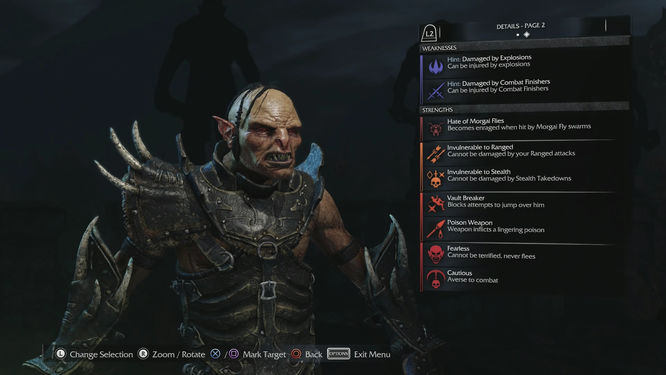
Oh Uruk-Hai There
Okay, that's two paragraphs down without mentioning the word 'orc', so perhaps it's time to rectify things. If that story synopsis waffled on a bit, let me cut right to the point. Shadow of Mordor is a game about orcs. Orcs, orcs, orcs. Over the course of your adventure, you will come to hate orcs, despise orcs, curse orcs at the top of your lungs; you'll be disgusted by their filthy ways (or may even grow fond of them), but whatever happens on your adventure through Sauron's domain, you're going to be killing an awful lot of the grubby things.
The in-game map of Mordor is essentially just a great big muddy field for you to run around in. It's a large wide-open area, dotted with huts, crumbling ruins, towers, caves and fortresses, and packed full of missions for you to do and things to find. It certainly looks good, but it's also not exactly the most graphically interesting backdrop to play in either, due to having a colour pallet that seems to consist mostly of "grey", with a few muddy browns and blacks thrown in for good measure. However, once you've started to make your acquaintance with Mordor's delightfully foul and cranky citizens, nothing else really matters.
As mentioned, the really unique element of Shadow of Mordor is without a doubt the Nemesis System, and it's such a fundamental part of the game that it needs explaining before we go any further. It's a simple enough concept, but one that's really, really effective. Whilst you're playing your way through the story, the game will randomly generate a series of Orc Captains for you to go up against. These are elite 'Uruk' orcs that command the various orc riff-raff in the world - and as you might imagine, these Captains are a tad more powerful than your standard orc cannon fodder. Each has their own particular strengths and weaknesses, resistances and even fears - all of which can be cleverly exploited. The identities of the orc hierarchy are all an unknown line up at the start of your game (which can be checked at any time by bringing up the pause menu), but you'll slowly discover the who's who of the upper echelons of the orc world over time. Much like a good game of Cluedo, only with clubs and swords and repeated stabbings instead of leading yes/no questions.

What's really clever is that the chain of command isn't a static, fixed thing. Nature abhors a vacuum as they say, so over time, orcs that you've previously killed will be replaced in the hierarchy by fresh new recruits. Orcs will fight amongst themselves for dominance, with the victor taking the ranking title. Crucially, being killed by an orc will lead to that orc being promoted, and usually challenging other higher ups in the chain as they feel a burst of confidence after giving you the killer blow. Any lowly orc in the game has the potential to reach the top of the hierarchy, so while dying doesn't really affect your character per se, it certainly carries a heavy price, and directly affects the balance of orc power quite dramatically.
In a nutshell, this means that any orc you encounter could ultimately become the stuff of nightmares; the nemeses you'll build up as you slash your way through Mordor can end up being some of the most epic and personal boss fights you can imagine in gaming. It's truly some special stuff.

Careful With That Axe Eugene!
So, we've talked a bit about the orcs - now let's talk about how you're going to go about killing them. The game openly encourages you to experiment with the three main combat approaches - offensive, ranged or stealth - as certain Captains will be resistant or even immune to certain methods, whilst vulnerable to others. Additionally, you can use the xp you earn from offing orcs to upgrade Talion's abilities. You can choose how and largely in what order you want to move through the upgrades and abilities, though you will need to play through story missions and take part in specific types of side missions to unlock the full skill tree. The Ranger upgrades focus on Talion's strength and offensive options, whilst the Wraith upgrades prioritise improving your stealth and ranged attacks.
As mentioned earlier, the combat feels very Batman-esque, which is great. Clashing with the orcs in direct combat with your sword is both thrilling and cinematic, and it's the way you'll be conducting a significant amount of your orc encounters.
The controls are straightforward and easy to pick up, even if you've never battled Gotham City's abundance of hired goons before; you'll soon be rolling, parrying and slashing your way through Sauron's armies with ease. Timing is important, as you have to block the telegraphed orc attacks, meaning that you can't just hope to run into a mob and mindlessly mash the attack button. As you progress through the game, you'll unlock the ability to perform other swashbuckling skills, such as mid-combat executions, along with the ability to wraith-stun an enemy in order to land a series of rapid fire strikes from your dead elf pal - just two of the techniques which are vital to surviving large packs of angry orcs.
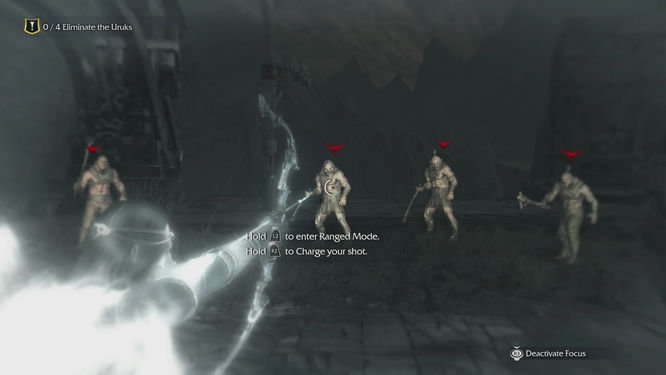
Outside of full-on combat, the dagger and bow weapons are the perfect tools for more stealthy players. Stealth attacks were our personal modus operandi, and due to the game's excellent stealth systems, using my dagger to quietly take out orcs one by one was always a lot of fun. Oddly enough, the bow was actually our least used tool (cool and ghostly it may be), as gallivanting around with the sword and dagger was too much fun. It's mostly useful for silently taking out enemies at range, though you can use it offensively in combat with the slow motion focus ability, providing you've got a bit of distance from your target.
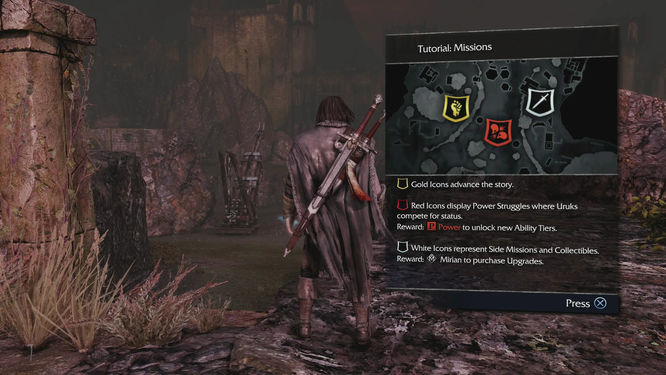
What... is your quest? What... is your favourite colour?
Okay, so to recap; we've got orcs - check. Weapons - check. But how does killing all these orcs fit in with the story and mission structure? Pretty well actually. You're free to choose whether you want to work through the main missions or tackle some side quests right from the off. Instead of safe houses, you can unlock new forge towers (found by using Celebrimbor's wraith vision) to use as respawn/fast travel points to make navigation around Mordor quicker, which also has the added effect of opening up new nearby missions and side quests to tackle.
Quests and side missions tend to occur dynamically in response to on-going gameplay, rather than feeling like overwhelming and pestering distractions to the main story. For example, after happening to come across a bunch of withered human slaves on my way to a main mission, I decided to help them out by stealthily knifing their loutish orc master. This then prompted some dialogue from one of the freed captives, who begged me to go and rescue more of their enslaved chums who were in need of help elsewhere - so off I went. If the game had simply said "Go here to free slaves", you wouldn't feel half as compelled to go and help the poor guys out.
In fact, the side missions and activities weave so fluidly with the main story quests and your own desire to explore, that it's actually a delight to be given a reason to go off and see something new. There's also smaller survival and hunting challenges (again similar to Red Dead) which are very basic and provide quick little xp boosts to keep that experience bar filling up at a regular pace, whilst never feeling like too much of a chore.
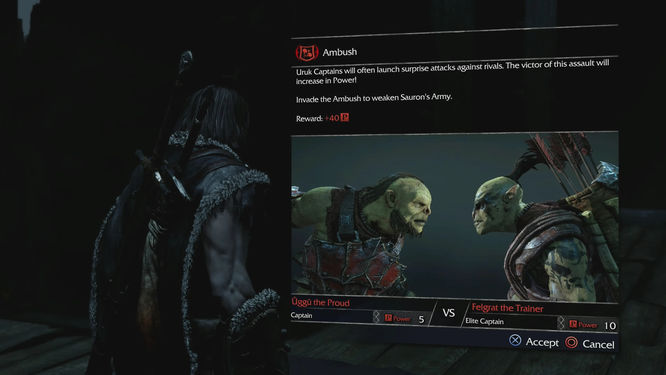
What's great is that the Nemesis System means that even a simple side quest can turn into the staging ground for another epic encounter with one of your orc rivalries. The most basic of fetch quests can dynamically change into a life and death struggle with one of your many nemeses at the drop of a hat... or an crude bone headdress if you're an orc.
Different power struggle events and missions will occur relative to the progression and movements of the orc hierarchy in your game. Orcs that manage to kill you will then usually try and challenge those higher up in the ranks for their position, and they will naturally bicker and fight amongst themselves for dominance even without your dead body as a bargaining chip. These struggles can usually be intercepted and disrupted if you choose, or ignored at the risk of letting one of the two ruffians grow more powerful.
These situations are ripe opportunities for presenting some interesting challenges to your overall game plan and strategy, in comparison to the face-to-face clashes you'll have with the orcs yourself. Do you sit back and let the quarrelling orcs battle it out amongst themselves, or do you get involved? Do you help the underdog orc battle the bigger bully, or do you help the superior one quickly wipe out the runt? The choice is up to you.
One problem with these power struggles (and fighting the more difficult orcs in general) is that it's quite hard to tell just how you'll stack up to an orc in combat before everything kicks off. Each of the Captains has a power level, giving you some assessment of how difficult they'll be to defeat in battle; the higher the number, the harder they will be to put down. However, you don't have a similar number in your stats telling you what rank you are, making it tricky to tell how capable you are of taking down your target. However, it's not a massive deal. With enough careful planning, you can tackle any orc, and the uber-powerful Warchiefs at the top of the hierarchy have to be specifically drawn out by completing certain missions, or by having a dominated (mind-controlled) orc challenge them directly, so you don't have to worry about dealing with the cream of the Uruk crop right away so to speak.
However, it's often on these power struggle/consolidation missions that your dreaded nemesis will decide to turn up and really throw a massive spanner in the works on what would have otherwise been a rather straightforward mission. There's nothing more (delightfully) frustrating than fighting your way through a bunch of orc thugs to close in with the killing blow on that specific orc captain you've come to slay, only for that pesky rival of yours to come jumping out of the sidelines at you; locking swords with you and snarling all manner of jibes and insults your way before attacking you as well, usually allowing your original target to get to his feet and flee or continue attacking. It's dynamic moments like these, where unwelcome surprise attacks from your nemeses suddenly shift the balance of power mid-combat that will teach you to both hate and respect the orcs in equal measure.
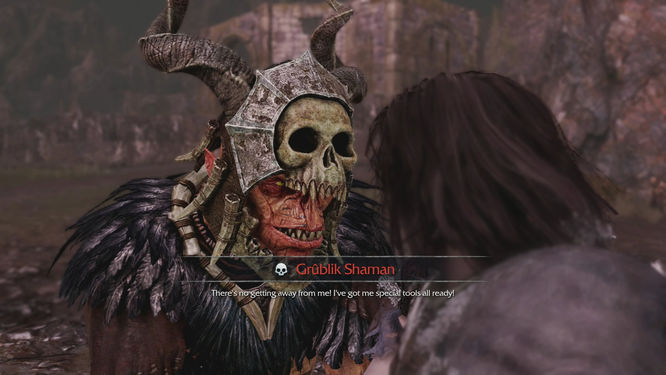
A dish best served... bloody
To give you some idea of how all these various systems work together in gameplay, we thought we'd share the story of our numerous clashes with our most bitter rival on our adventure through Mordor, and how we eventually bested him. Get comfortable, as it's an epic and bloody tale of woe, misery and, ultimately, gleeful success.
Upon starting the game, we leapt out of the starting tower, and cockily strolled up to a bunch of the local warty fellows, eager to remove some orc limbs from their rather portly torsos.
Things were going well; blood was shed, limbs were indeed severed, and we were having a whale of a time... only to be swiftly challenged by the dastardly devil who would be one of our longest running rivals - Grûblik the Shaman.
Despite our best efforts (frantically mashing the attack button, completely forgetting to block) we were slain by the dastardly devil, which to our annoyance, resulted in Grûblik rising up the ranks and growing more powerful - the smug git. Several more times we'd try and take down this growing thorn in our side, only for him to either best us again in combat, or flee when the battles weren't going his way.
Why is this fun we hear you ask? Well, there's nothing more satisfying than finally putting the kibosh on your most bitter rival. The day when Grûblik finally bit the dust was nothing short of glorious.
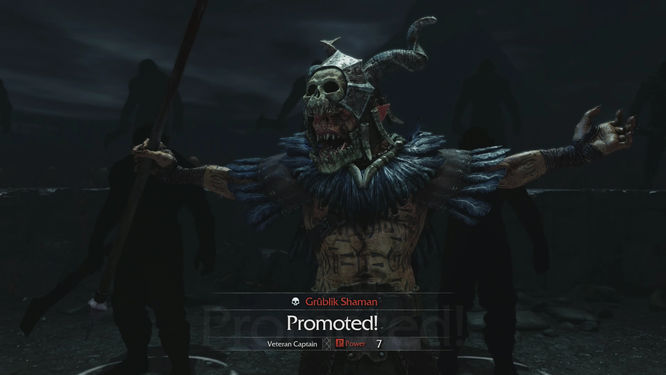
As a Shaman, one of Grûblik's traits was that he could quickly summon minions to his aid in battle using a snazzy horn - and due to whatever black magic he was no doubt dabbling in, he could also regenerate health at a fast rate as well. What made him incredibly hard to kill was that he could summon such large groups of orcs to his aid that it would quickly become impossible to focus on Grûblik in a fight. You might get a couple of swift stabs in on him, only to have to instantly parry or dodge one of his minions - by which time Grûblik would be able to scurry out of immediate reach, and by the time you caught up to him again, he'd be fully healed. Annoying to say the least.
So, having found out that running in screaming with our sword drawn wasn't the way to go, we tried another method - a stealthy surprise attack with a dagger. Tracking down further intel on Grûblik let us discover he was vulnerable to a one-hit stealth attack, if performed completely undetected. Needless to say, it worked like a charm. Discovering the magic man marching around a nearby courtyard, we climbed the surrounding crumbled ruins and performed a flashy airborne stealth kill from above, finishing the rotten devil off for good. Seeing our rival crumple to the floor and his minions scatter to the wind in fear felt incredibly satisfying after he'd absolutely battered us time and time again.
The fact that all these encounters were essentially random dynamic elements that were totally unscripted is some seriously impressive stuff. Grûblik will forever be in our mind as one of the most irritating and memorable mini-boss encounters that we've had the pleasure of battling in a game in quite some time.
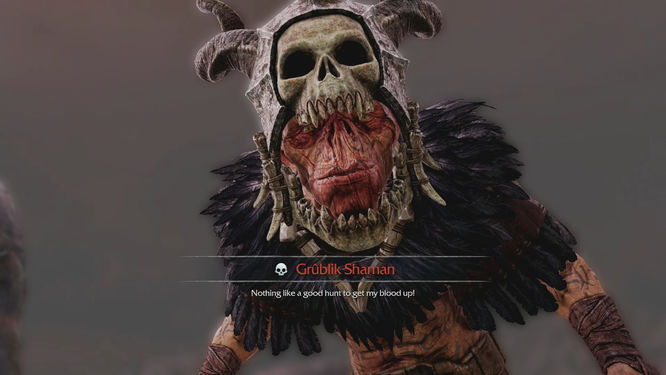
Rise from your grave!
Unfortunately, there's a catch. The Nemesis System is far from perfect. In fact, it can be downright baffling... so much so that we're not entirely sure how it works even now. You see, what's really odd (not to mention startling at times) is that the Orc captains don't seem to actually stay dead, even once you've apparently killed them... brutally at times.
It makes sense story-wise for your character to keep resurrecting, being possessed by a dead elf and all that, because... you know, reasons, but it can be really bizarre to keep coming up against orcs that you know you've already put into the ground once already. As you can imagine, being attacked by none other than Grûblik the (now presumably undead) Shaman out of nowhere was frightening and confusing in equal measure, especially as we thought we'd slain him only a few hours ago. Although, on the plus side, we were at least partially pleased to see him back, if only so we could stick our knife into his warty neck once more.
The game doesn't really explain this anywhere, so instead we've had to look up what on earth was going on online. Even now, it's still hard to understand how and why this works. Apparently, if you aren't decapitating your orc rivals using a combat execution, then they can come back again and again like common or garden zombies. They might look slightly different, but it'll be them - they'll usually have different characteristics and appearances, but they'll retain their name, and despite whatever the bizarre resurrection process has entailed, they will remember you and what you've done to them.
This unfortunately means that unless you're usually favouring rushing aggressively into battle with your sword aloft, then you're going to struggle a bit if you want to use stealth or ranged weapons. Seeing as we favoured playing stealthily - being able to stealth run made sneaking up behind orcs extremely good fun, and using guerrilla tactics to whittle down the unaware enemy forces one by one felt great - we weren't executing a lot of our orc rivals face-to-face with the sword, which gave them a nasty habit of apparently resurrecting and coming back even angrier (not to mention uglier) than before. This really detracts from the impressive things that the Nemesis System absolutely nails, and repeatedly bumping into these supposedly 'dead' orcs time and time again can be both frustrating and immersion breaking.
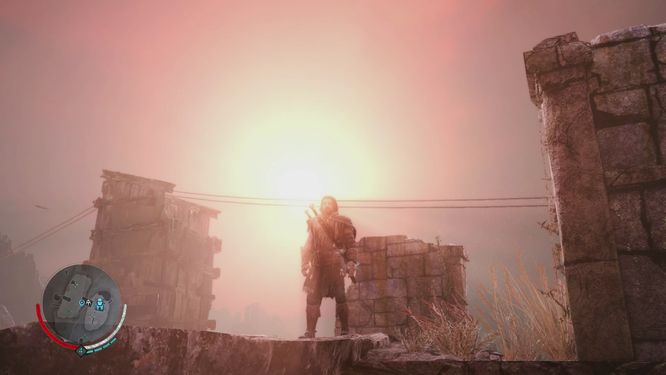
Orcs well that ends well
Normally, a game will make the basic foot soldiers you run across feel almost like part of the backdrop; you just blast/stab/shoot your way through them and carry on with the rest of the game. Shadow of Mordor flips all that round, and instead celebrates the writhing and vulgar underbelly of Tolkien's world as the absolute star of the show.
By simultaneously allowing both you and your enemies the ability to level up and learn from each encounter, the game cleverly manages to make you feel ever more powerful and capable, yet still give great deal of significance and consequence to your deaths. While mysteriously resurrecting orcs will somewhat confuse and muddy your understanding of the Nemesis System when they turn up, the spontaneity and dynamic nature of the enemy orc hierarchy still makes it a ridiculously refreshing experience.
The Nemesis System is a feature that plenty of games going forward are bound to draw inspiration from, as it managed to turn the land of Mordor from, what you'd think from reading the books, would be a dead and lifeless pit of despair, into a thriving and eclectic mix of thugs, rapscallions and scum bags. It's a pleasure to meet them all... before stabbing them, repeatedly, of course.
Format Reviewed: Playstation 4


